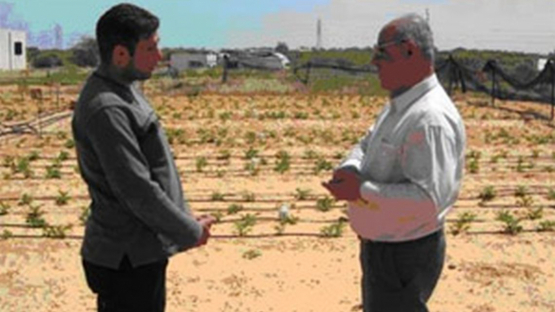
If you would like to learn more about the IAEA’s work, sign up for our weekly updates containing our most important news, multimedia and more.
Improving Agricultural Water Management for Crop Productivity in Africa
Agriculture is the largest consumer of water; accounting for over 70% of the world's freshwater diversion.
However, only a part of this agricultural water diverted is effectively used in the production of food or other agricultural commodities and the remaining does not reach the crop/plants because of losses through soil evaporation or infiltration through cracks, root channels, and/or used by weeds. With increasing variation in rainfall distribution resulting from climate change and variability, water allocation for agriculture is facing increasing competition from non agricultural users.
The main challenge confronting water management in agriculture is to improve water use efficiency and its sustainable use. This can be achieved through (i) an increase in crop water productivity (an increased in marketable crop yield per unit of water transpired) through irrigation, (ii) a decrease in water losses through soil evaporation that could otherwise be used by plants for their growth, and (iii) an increase in soil water storage within the plant rooting zone through better soil and water management practices.
The Soil and Water Management and Crop Nutrition Subprogramme is currently working with many Member States to improve agricultural water management through both coordinated research projects and technical cooperation (TC) projects. Using isotopic and nuclear techniques, constraints to water use efficiency were identified and appropriate land and irrigation management practices were put in place to enhance more crops per drop of water and improve soil water storage.
For example, in Libya, with proper fertigation management identified through nuclear techniques resulted in tremendous savings of water and fertilizer and reduced the environmental impact of irrigation and fertilizer application. Fertigation which is the application of fertilizer through drip irrigation system is an efficient way of controlling water and nutrients in the root-zone helped to increase yield of the potato tuber by more than 150%, and reduced the water and nitrogen (N) fertilizer use by more than 50%. Additional benefits include savings on chemical and labor with increased income for farmers. With support through IAEA's TC, drip irrigation and fertigation is becoming a well adapted water management practice on light -textured soils of coastal belt in Libya. The Biotechnology Research Center in Tripoli carried out a series of drip fertigation for potato production. Mr. Abdulhafied Ellafi of the National Scientific Research Council, Tajoura Nuclear Research Center is extremely happy with the outcome from the association of his Centre with the IAEA when he is stating that "Through IAEA assistance, we were able to show that drip fertigation is a potential irrigation and N management tool for potato production in Libya that can improve field water-use efficiency and N fertilizer utilization. For the first time soil moisture neutron probe and 15N labeled fertilizer was used to measure soil water and evaluate nitrogen recovery by plant".
Kenya is one of the 18 African countries participating in a new regional irrigation project to introduce and pilot-test appropriate small scale irrigation technologies (SSITs) with the aim of developing irrigation systems for small-scale farmers for increasing yield and quality of high value crops, and to improve their income and livelihood. Mr. Isaya V. Sijali from the Kenyan Agricultural Research Institute (KARI) says 'The use of nuclear and isotopic techniques is instrumental in improving the livelihood of farmers'. Mr. Sijali also thanked the Agency for the continuous support to KARI over the past several years and for strengthening nuclear science and technology in Africa. Through IAEA's capacity building, KARI has achieved a level of technical capability to be a training centre for many African fellows.

